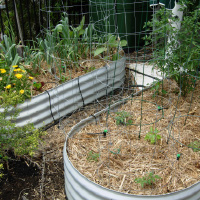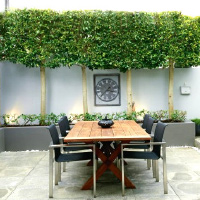from Kowhai Thompson
Permaculture – The Joys of Mulching
 Now that the Summer is over it’s a great time to put mulch on the garden. In permaculture, mulch is used regularly. So what is mulch and what does it do? Mulch refers to any organic material that is used as a top dressing on a garden bed. Some examples are compost, bark, sawdust, shredded leaves, pine needles, grass clippings, or peastraw.
Now that the Summer is over it’s a great time to put mulch on the garden. In permaculture, mulch is used regularly. So what is mulch and what does it do? Mulch refers to any organic material that is used as a top dressing on a garden bed. Some examples are compost, bark, sawdust, shredded leaves, pine needles, grass clippings, or peastraw.
Mulch fulfils a number of roles in a garden, it keeps moisture in, it breaks down and adds organic material to the soil, it attracts worms to the surface, it protects the soil from wind erosion and also helps keep weeds down. This time of year, Autumn leaves are in good supply and make a lovely mulch added in thick layers at the base of nutrient hungry plants such as blackcurrants and raspberries. You can also store them in a large bin over winter. They will break down slowly as a wonderful Spring mulch. Grass clippings can be great too, but only if the lawn was mown before seed set. It’s helpful if there are dandelions, plantain and clover in the lawn too which will also add extra nutrients. Do not mulch too closely around the stems of shrubs or this rich mulch may burn the plants. Permaculture is less concerned with visual perfection, but rather with effectiveness and growth results.
Hedge trimmings and other shrubby waste is an excellent mulch underneath hedges and trees. These woody bits if chopped into small pieces will be broken down by fungal soils. Fungi rich soil in return aids the growth of the trees and shrubs. Win win!
For the extra keen: to lift your mulching to the next level, try to balance the carbon and nitrogen. A carbon layer such as dead leaves or trigs will remove nitrogen from the soil briefly as it breaks down. Help prevent this by laying down dead leaves (high carbon) with fresh lawn clippings (high in nitrogen) or laying down peastraw (mostly carbon) over a layer of compost (high in nitrogen). Apply mulch 2 – 4 inches thick.
Landscape Design Trends for the Home Garden
Whether you are interested in garden trends or prefer to stick to tried and true, here are a few trends in landscape design to be aware of.
Go dark
There is a movement towards darker colours for garden structures such as fences, walls and sheds. This has spread from the trend for darker coloured homes. The greens and silvers of a garden appear to beautiful effect when contrasted against a dark background. Watch for charcoal, black, dark green and dark blue fences, pergolas and retaining walls.
Restrain yourself – simplicity of palette
With the business of life for many professional people there has emerged a tend for simple plant palettes in the home garden. One or two flower colours, and simplified foliage colours to create a restful look. Plantings are in groups.
Stay outside – outdoor rooms
The outdoor entertaining experience is important for New Zealanders, outdoor furniture ranges are expanding and including pizza ovens, soft furnishings that can be cleverly stored away, entertaining courtyards with bar leaners, lighting, raised planter boxes, and wired music systems. People are looking for more luxury entertaining beyond the basic table and umbrella.
Grow food
Finally, edible landscaping has become mainstream. Watch for cranberry hedges, feijoa hedges, herbaceous borders with sage and chives, grapes clambering over pergolas, and beautifully designed raised beds for herbs and vegetables.
Edible gardening structures such as compost bins bee hives become more well designed. There is a trend towards foraging/homesteading so watch for permaculture features such as chicken runs and mini orchards with dwarf fruit trees to spread.

